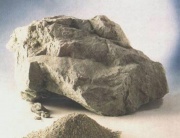Difference between revisions of "Argil"
Jump to navigation
Jump to search
(username removed) |
(username removed) |
||
| Line 10: | Line 10: | ||
== Authority == | == Authority == | ||
| − | * | + | * Thomas Gregory, ''The Condensed Chemical Dictionary'', Reinhold Publishing, New York, 3rd ed., 1942 |
| − | * | + | * Susan E. Schur, Conservation Terminology: A review of Past & Current Nomenclature of Materials, ''Technology and Conservation'', Spring (p.34-39); Summer (p.35-38); Fall (p.25-36), 1985 |
| − | * | + | * Random House, ''Webster's Encyclopedic Unabridged Dictionary of the English Language'', Grammercy Book, New York, 1997 |
* ''The American Heritage Dictionary'' or ''Encarta'', via Microsoft Bookshelf 98, Microsoft Corp., 1998 | * ''The American Heritage Dictionary'' or ''Encarta'', via Microsoft Bookshelf 98, Microsoft Corp., 1998 | ||
Revision as of 07:39, 24 July 2013
Description
A fine, white clay used by potters. Prior to the 1800s, term argil refer to all aluminum-containing clays, but was later standardized as alumine (Schur 1985). The name argil is still refers to a fine quality potter's clay.
Synonyms and Related Terms
argilla clay; argilaceous earth; alumine; argilla (Lat.); kaolin; potter's clay; kaolin (Fr.);arcilla (Esp.); argila (Port.); Kaolin (Deut.)
Authority
- Thomas Gregory, The Condensed Chemical Dictionary, Reinhold Publishing, New York, 3rd ed., 1942
- Susan E. Schur, Conservation Terminology: A review of Past & Current Nomenclature of Materials, Technology and Conservation, Spring (p.34-39); Summer (p.35-38); Fall (p.25-36), 1985
- Random House, Webster's Encyclopedic Unabridged Dictionary of the English Language, Grammercy Book, New York, 1997
- The American Heritage Dictionary or Encarta, via Microsoft Bookshelf 98, Microsoft Corp., 1998
